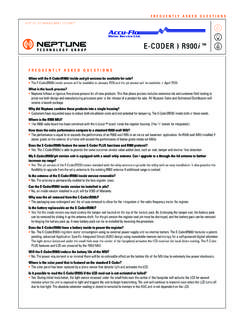Transcription of The Ultimate Guide To Home Aquaponics System
1 The Ultimate Guide To home Aquaponics System 2 | Page The Ultimate Guide To home Aquaponics System The Ultimate Guide To home Aquaponics System 3 | Page Table of Contents How To Use This Book 4 Part 1: Introduction Why Try Aquaponics ? 7 Aquaponics Quick Facts 11 Small But Efficient: The Solar Pond 13 Variant aquaponic Systems 15 Experimenting With Water Flow 18 Primary Considerations When 20 Using Plastic for Aquaponics Essential & Optional Components of an aquaponic System 22 Part 2: Setting Up an aquaponic System Setup for a home -Sized aquaponic System 27 The Ultimate Guide To home Aquaponics System 4 | Page Operating the home -Sized aquaponic System 37 Frequently Asked Questions (FAQ) About Aquaponics 40 In Focus: aquaponic Fish & Plants 50 Native Aquatic Life vs.
2 Exotic/Foreign Aquatic Life 50 Keeping the System in Balance 52 Fish Density Per Holding Tank 53 Advantages of Low Fish Density Per Tank 54 Keeping the Fish & Plants Healthy 55 Get Ready for Blooming Grow Beds 57 aquaponic System Troubleshooting 60 References 66 The Ultimate Guide To home Aquaponics System 5 | Page How to Use This Book The Ultimate Guide To home Aquaponics System was designed for the backyard hobbyist and for curious individuals who wish to know how to create their very own aquaponic System at home with the least amount of hassle. This book has been divided into two parts.
3 Part 1: Introduction contains the basic principles of an aquaponic System . The section Why Try Aquaponics ? contains an overview of what Aquaponics technology is. It also delineates the differences between Aquaponics and regular pond aquaculture and hydroponics. You ll find a simple breakdown of how an Aquaponics System works in the section Why Try Aquaponics ? For a quick Guide to the intricacies of Aquaponics , check out the section Aquaponics Quick Facts. A description of how a small aquaponic System , the solar pond, works can be found in the section Small But Efficient: The Solar Pond. An explanation of the most common variations of aquaponic systems can be found in Variant aquaponic Systems.
4 For a quick Guide to flow systems, read the section Experimenting With Water Flow. A definitive explanation of the role of plastic containers in aquaponic systems can also be found in Primary Considerations When Using Plastic For Aquaponics . The Ultimate Guide To home Aquaponics System 6 | Page When you re ready to build your own aquaponic System , jump over to Part 2: Setting Up An aquaponic System . The section Setup for a home -Sized aquaponic System contains all the steps for creating a real aquaponic System in your own backyard. Have questions? Head over to the section Frequently Asked Questions (FAQ) About Aquaponics for some definitive answers.
5 If you are having problems with an established aquaponic System , read the section aquaponic System Troubleshooting for some quick answers. The Ultimate Guide To home Aquaponics System 7 | Page Part 1: Introduction Many years ago, a friend of mine introduced to me the concept of Aquaponics . At first, the idea seemed a bit crazy take care of fish, and let vegetables/fresh produce grow with the help of the nutrients present in the fish tank. Let me be honest with you: I have no green thumb. I m no farmer, and I am certainly no fish expert. And yet, something about Aquaponics caught my fancy. It was the idea of true self-sufficiency that made me try it.
6 I imagined myself being able to grow a clean protein source (fish) and a steady source of vitamins, minerals, and fiber (vegetables). It was really the stuff of dreams. Who hasn t dreamed of being able to pick clean and tasty food from their own yard? And then there I was looking at a simple blueprint for a backyard aquaponic System . My friend told me that he didn t have the time to experiment in his own yard and he thought about me when he was about to throw away the blueprint. I took the blueprint, thanked my friend, and embarked on my own personal backyard adventure. I never looked back. Now my own aquaponic System is steadily producing tilapia and other edible fish, and I have fresh vegetables to harvest every few months.
7 You can do this, too! The Ultimate Guide To home Aquaponics System 8 | Page Why Try Aquaponics ? Aquaponics is an efficient answer to the most basic requirement of modern living: a clean and sustainable source of food. Traditional aquaculture and farming are out of reach for the majority of individuals in the country. Not everyone has a large space that can be dedicated to a conventional vegetable garden. Shortage of usable space prevents people from even trying farming their own food. Aquaponics eliminates these problems because this type of System does not require a lot of space. What is Aquaponics , anyway?
8 Aquaponics is simply a hybrid of aquaculture (farming of fish) and hydroponics (vegetable farming with the use of a water-based medium). Aquaponics combines the best of both systems. This translates to more advantages for the Aquaponics farmer. How does an aquaponic System work? The Ultimate Guide To home Aquaponics System 9 | Page Here s a simple breakdown of what happens in an aquaponic System : 1. Freshwater fish like tilapia are placed in holding tanks. The holding tanks have simple aeration systems to help oxygenate the water. 2. The fish are fed with pellets or organic/natural fish food. 3. The fish eat the food and produce waste.
9 The waste from the fish mixes with the water. Detritus and unused fish food also accumulate in the holding tank. 4. Some of the water from the holding tank is pumped out to the growing beds. 5. Vegetables are planted on the growing beds. The plants make use of the nutrients present in the water from the holding tanks and also purify the water. 6. Purified and oxygenated water from the growing beds is transported back to the holding tanks. 7. The fish benefit from the purified and oxygenated water and the cycle is repeated ad infinitum. Because of the nutrient-rich water, vegetables grow continuously. An aquaponic System can also be expanded all you have to do is add more holding tanks (or increase the capacity of an existing System ) and make larger growing beds.
10 The Ultimate Guide To home Aquaponics System 10 | Page An aquaponic System thrives because of three main components: Edible fish + bacteria in the water + plants Of course, there is also sunlight, which makes it possible for vegetables and other plants to grow. It s a beautiful and simple System that produces almost no waste because the waste itself is used up by plants. At the outset, you have the fish and the plants. Where would the bacteria come from? The bacteria will come soon enough. Once the fish in the tank start expelling waste, two types of bacteria will start to grow in the water. The bacteria present in the water will help break down fish waste and chemicals such as ammonia.








